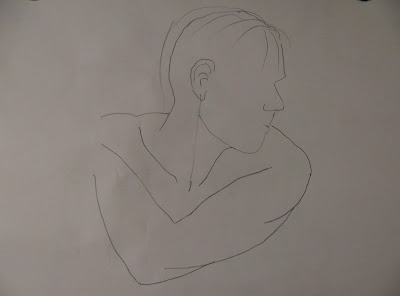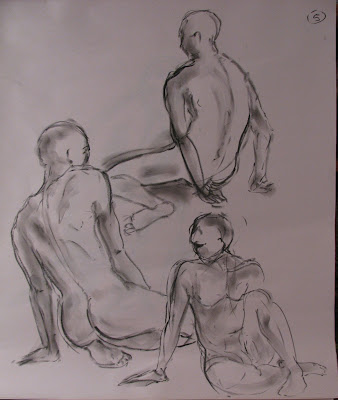A new year -- and time to pick up the beat! Searching through my pile of "postcards" (the quick things I splash down in the interest of using up excess paint), I found this dancing figure to be the perfect symbol for the season. (It's based on a beautifully photographed dance festival program.)
I'll tell you something, though. Picking up the beat North American-style can't begin to compare to the pulsating performance of the flamenco dance troupe I watched and tried to sketch in a darkened theatre in late November. Theirs was another surprising performance at the Dance Centre where I try to catch their low-cost noontime performances and, sketchbook in hand, see what I can capture of fast-moving dancers.
I'd braced myself for something intense and rather anguished, like the flamenco guitar music I'd heard before. It turns out, though, that there are many kinds of flamenco -- and this performance must have been based on the graceful, the joyous, and the thrilling.
There were three dancers, sometimes performing together...
...and sometimes dancing solo.
What was truly mesmerizing was the beat -- or, as it's called, the compás -- the profound, deeply embedded characteristic "anchor" to all flamenco. Each set might start with a single dancer, moving with stamping feet to her own accompaniment of clapping hands.
Then, the demure, refined singer in her high-necked, long-sleeved flowing dress would seamlessly join the compás or sometimes, acapella, she might begin the set herself.
Finally the guitarist, who later described himself as the least important of all, would join in.
Throughout, at just the right intervals, the beautiful young singer would call out encouragement to the dancers with what sounded almost like the French "Allez!" with a soft ending -- "Alleh" you might say. This turned out to be "olé" pronounced with soft yet insistent vowel sounds.
The finale had a truly touching moment when the troupe's founder and director stepped into the circle. An ardent woman in perhaps her mid-60s, she was dressed in a long-sleeved black tunic with black leggings and boots. She stepped forward, effortlessly picking up the compás, dancing to perfection the pulsing steps she'd learned so long ago, moving towards her young dancers with emphatic hand-clapping, saluting them -- as they in their turn acknowledged her expertise with hand-clapping salutes in return.
If I seem to be a mini-expert on compás, it's because these midday Dance Centre performances always conclude with an informal discussion session. The founder-director had only about ten minutes to speak and said the absolute basic thing to understand about flamenco was its 12-beat rhythm -- and the necessity for all the participants to have/understand/know/feel this, the compás.
It's almost always set by the dancer (occasionally by the singer) and supported by the singer and the guitarist -- and just to make things very interesting, it's subject to change as the piece develops and the dancers innovate. Both the director and the guitarist talked about how it took time and extraordinary effort to learn these rhythms which then become totally intuitive and organic -- exactly as I had just witnessed. The flamenco rhythms are more fully explained here, oddly enough by a company that manufactures a device that purports to help teach them!
In this playful interval in the last week of the year, I thought I'd see what kind of "postcards" I could develop from my drawn-in-the-dark sketches. Here's one of three dance poses.
But really, it was a you-had-to-be-there kind of experience, one of so many good experiences I had in 2017. On that note -- on that beat -- let's bring in some more of the troupe and say "Olé!" for the year 2018.




















































